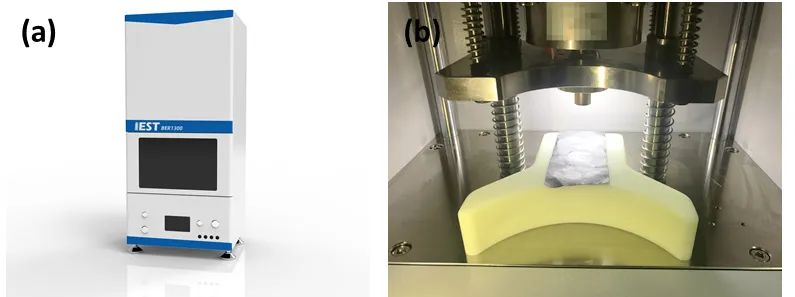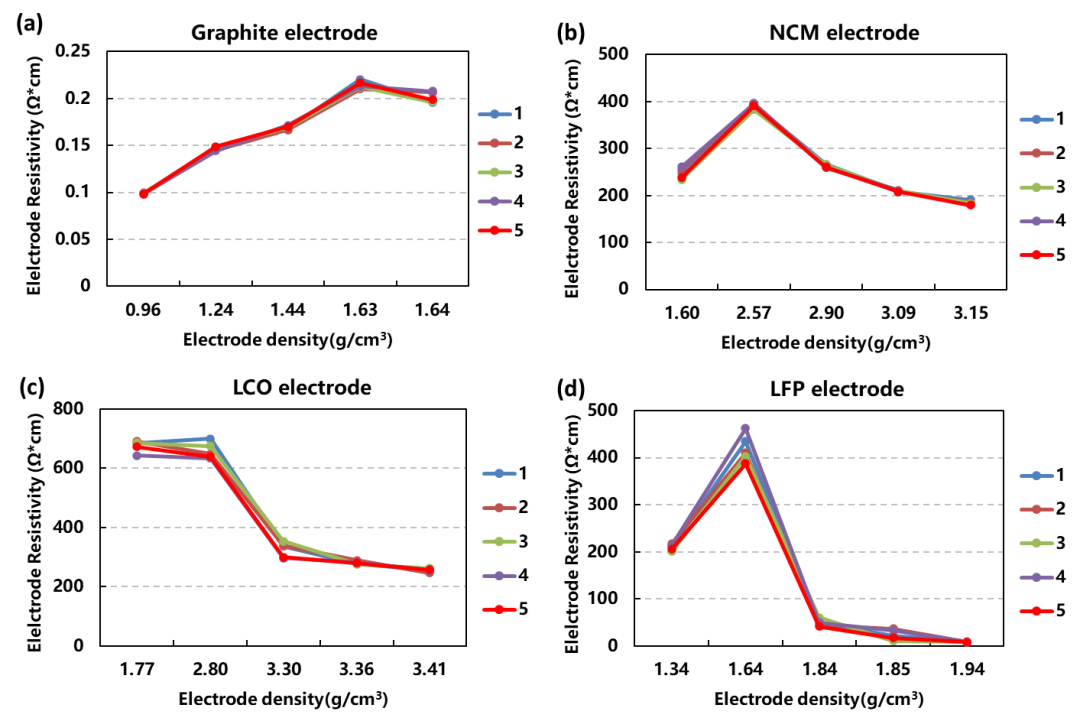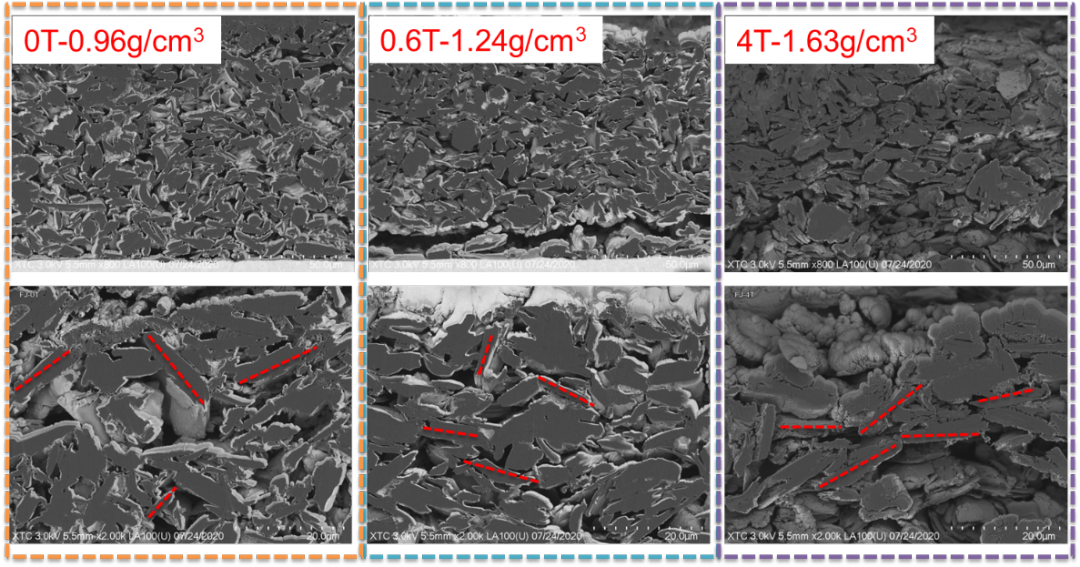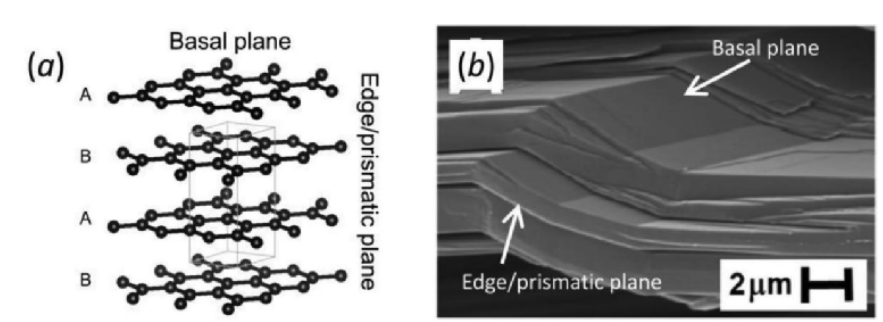Correlation Analysis Between Lithium Electrode Resistance and Roller Compaction
The electrode plate resistance represents the electronic conductivity of the electrode plate, and this parameter is closely related to the compaction density, porosity, formulation, etc. When the pole in the preparation process, after different roller pressure, will change the surface roughness and compaction density of the pole of the contact between active particles in the pole conductivity and improve the volume energy density of the cell has a certain positive effect, but in the process of roller pressure, the particles in the pole in addition to longitudinal extrusion, also by lateral shear force, can make the particle rearrangement.
When testing the electrode resistance of the electrode, the upper and lower electrodes are perpendicular to the surface of the electrode, and the applied electrical signal runs perpendicular through the pole surface of the other side of the electrode, on the one hand measures the conductivity of the particles themselves, on the other hand also includes the contact resistance between the particles and the particles. Therefore, with the increase of the roller compaction density, the positive and negative electrodes of different systems.
1.Experimental Equipment and Test Methods
1.1 Experimental Equipment:Battery Electrode Resistance Analyzer,BER1300 (IEST), electrode diameter of 14mm,can apply a pressure of 5~60MPa.
The Equipment is Shown in Figure 1 (a) and 1 (b).

Figure 1. (a) BER1300 appearance diagram; (b) BER1300 structure diagram
1.2 Sample Preparation: Single pole sheet is prepared, slurry ratio is respectively, negative powder: SP: CMC=90:5:5, positive powder: SP: PVDF=96.5:1.5:2, after coating and drying, use the roller press different pressure roller pressure, prepare different compaction density of the pole plate.
1.3 Test Method: Cut the electrode piece to be measured before and after the roller pressure into a rectangular size of about 5cm 10cm, and place it on the sample table, and set the parameters such as test pressure and pressure retention time on the M RMS software to start the test. The software automatically reads the data of electrode thickness, resistance, resistivity, and conductivity.
2.Data Analysis
The resistance test is conducted before the single side positive and negative electrode sheet roll pressure and after different roller pressures, and the data results are shown in Figure 2. From the result trend, with the compaction density of roller, and only above 1.63g/cm³ compaction density conditions, the compaction density of the ternary NCM plate is 1.60g/cm³, the corresponding resistivity is relatively small, once after the roller pressure, the resistivity shows the trend of the first rise and decline, lithium cobalt oxide LCO and lithium iron phosphate L FP electrode resistivity trend is similar to the three before the first compaction density point after the roll is not different.
The internal electrons of the battery electrode coating are also mainly transmitted through solid powder particles, including the conductivity of the active particles, the conductive agent particles themselves, related to the structure of the material and the contact resistance between solid particles, the contact resistance between active particles, and between active particles, and between conductive agent particles. For the positive electrode, the electron conductivity of the active material is much lower than that of the conductive agent particles, and the conductance of the active particle is almost negligible. The graphite negative electrode itself also has a good electrical conductivity, and both the active particles and the conductive agent are the main electron conduction path. For the contact resistance between particles, this is related to the contact area, interface state and other factors.
The roller pressure hardly changes the resistivity of the active material and the conductive agent itself, but only the particle contact area and the interface state change caused by the rearrangement of the particles, thus affecting the interface resistance. In addition, in addition to the resistance process of the electrode plate resistance test, the tested resistance of the electrode plate coating also includes the interface resistance of the coating and the fluid collector, and the contact resistance between the probe and the coating, etc. It is generally believed that roller pressure will increase the compaction density of the coating, increasing the contact area between the particles, thus increasing the conductivity. However, the actual test results are more complicated. Next, the reasons for the change trend of the electrode resistance are analyzed by means of electric mirror and surface roughness.

Figure 2.Trend diagram of pole sheet resistance before and after different pressures of positive and negative pole roll
Through the cross-section SEM observation of the three graphite pole sheets with different compaction densities, it can be seen that with the increase of the roller pressure, the original cross-arrangement structure of the graphite sheets tends to be arranged in parallel. For graphite materials, its crystal structure is composed of carbon hexagonal sheet layer parallel arrangement, divided into plane and end surface, most of the lithium ions are embedded into the graphite layer from the end surface. In addition, the carbon atoms between the graphite layer are combined with three electrons with covalent bonds of SP2 hybridization, and the remaining one π electron can move freely to have good electron conductance, but it has significant anisotropy, and has good electronic conductivity along the level direction, while the electron conductivity in the vertical level direction is very poor.
Therefore, when the graphite electrode sheet passes through the roller pressure, more planes are parallel to the electrode sheet surface, which will make the current perpendicular to the electrode sheet applied during the electrode sheet resistance test more difficult to penetrate the electrode sheet coating longitudinally, so the resistance will increase with the increase of the roller pressure. On the other hand, as the compaction density increases, the contact between the graphite particles and the conductive agent particles becomes more dense chamber, which reduces the resistance, and the two pairs affect the resistance of the electrode sheet. Therefore, the influence of the actual roller pressure process on the pole sheet resistance is very complex, which needs to be analyzed combined with the specific material morphology characteristics and the microstructure of the pole sheet. On the one hand, the electrode resistance resistance can be analyzed by the electronic transmission characteristics combined with the microstructure; on the other hand, the electrode resistance test can describe the uniformity of the same group of electrodes to evaluate the uniformity of the electrode resistance.

Figure 3. Section diagram of the graphite electrode sheet with different compaction densities

Figure 4. Graphite crystal structure and morphology diagram¹
For three sets of positive electrodes, the measured resistance of the electrodes after a smaller pressure roll pressure is larger than the pole plate resistance before the roll pressure. As described above, the electrode plate electron conductivity is mainly formed by the electron conduction between conductive agent particles, in slurry preparation, conductive agent evenly dispersed in the solvent, formed a better interconnected 3 d electron transmission network, the subsequent coating and drying process, conductive agent 3 D network structure maintains good connectivity, although poor contact between active particles, but the conductive agent network makes the electrode has good electronic conductivity, electrode low resistance. The conductive agent electronic transmission network is broken at lower roller pressure, resulting in increased pole resistance. Combined with three different roller pressure of ternary electrode surface topography map and surface carbon distribution diagram can be inferred that after roller pressure, coated on the surface of active particles of conductive carbon molecules may not roll pressure lateral shear force extrusion, disconnected between the conductive agent particles, cannot conduction electron, so the resistance will be compared before the roller plate resistance increases.
Moreover, this may also be related to the constantly decreasing roughness of the polar sheet surface, as shown in Figure 5. Because the electrode resistance measured by the electrode resistance test principle of the upper and lower probes inevitably contains the contact resistance between the upper and lower electrodes and the electrode surface, if the roughness of the electrode surface becomes smaller, the contact between the test electrode and the electrode surface becomes worse, and the contact resistance becomes large, thus the measured total resistance becomes large.
As the roller pressure increases further, the active particles are further compacted, and the conductive carbon particles contact each other closely, forming a reconnected 3 D network, so the polar resistance is reduced. Therefore, the positive pole sheet roller pressure needs to ensure the larger roller pressure, otherwise the slight roller pressure will destroy the electronic conductive network, increase the electrode resistance, is not conducive to the performance of the battery performance. In addition, when testing the electrode plate resistance of the positive electrode plate, the surface state of the electrode plate should be kept as far as possible, so as to compare the influence of different process formulas on the electrode plate resistance can be used, and the electrode plate coating uniformity can also be evaluated by testing the resistance uniformity of different positions in the same group of electrodes.

Figure 5. Trend of the surface roughness of the three positive electrode sheets

Figure 6. Surface EM and carbon distribution of three ternary plates
3.Summary
In this paper, the resistance of positive and negative electrode sheets with different rolling densities was characterized, and it was found that the resistance of positive and negative electrodes changed with the increase of rolling densification. The maximum value is related to the orientation of the pole piece, while the resistance of the positive electrode first increases and then decreases with the rolling, which is related to the electron transport path of the three-dimensional network of the conductive agent of the pole piece and the roughness of the surface. Therefore, when using the pole piece resistance method to evaluate the difference in the conductivity of the positive and negative pole pieces and the uniformity of conduction, special attention should be paid to the orientation of the active particles and the consistency of the surface state of the pole pieces.
4. Reference Material
1.Henrik Lyder Andersen, Lisa Djuandhi, Uttam Mittal, Neeraj Sharma, Strategies for the Analysis of Graphite Electrode Function, Adv. Energy Mater., 2021, DOI:10.1002/aenm.202102693
2.Hiroki Kondo et al. Influence of the Active Material on the Electronic Conductivity of the Positive Electrode in Lithium-Ion Batteries[J]. Journal of the Electrochemical Society, 2019,166 (8) A1285-A1290.
3.B.G. Westphal et al. Influence of high intensive dry mixing and calendering on relative electrode resistivity determined via an advanced two point approach[J]. Journal of Energy Storage 2017, 11, 76–85.
